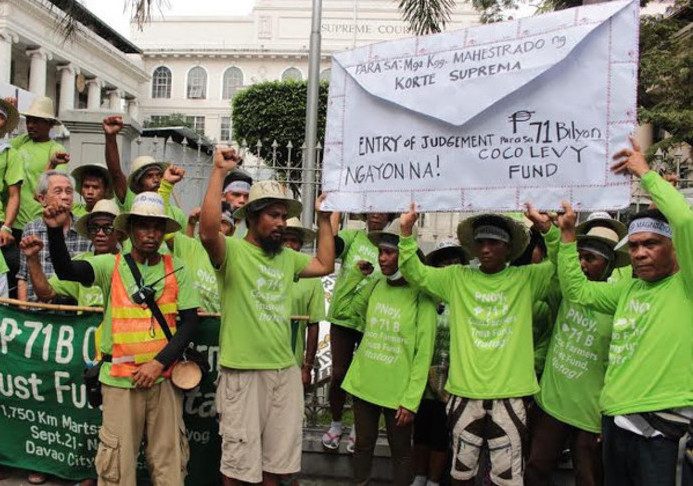SUMMARY
This is AI generated summarization, which may have errors. For context, always refer to the full article.

MANILA, Philippines – The anti-graft court Sandiganbayan has settled the ownership row of at least P75 billion in coco levy fund and assets, and ruled to execute the Supreme Court (SC) ruling that the funds are owned by the state to be used for the benefit of coconut farmers.
“All income, interest, or profits derived from these assets, to be used only for the benefit of all coconut farmers and for the development of the coconut industry,” the Sandiganbayan’s 2nd Division said in a 14-page ruling promulgated on August 7.
It was penned by Associate Justice Michael Frederick Musngi, with concurrences from Associate Justices Oscar Herrera and Lorifel Pahimna.
The 2nd Division justices backtracked on their ruling in December 2017 where they ordered further hearings to give the United Coconut Planters Bank (UCPB) and the United Coconut Planters Life Assurance Corporation (Cocolife) the opportunity to tell the court how the ruling would affect their operations.
What does this ruling mean? It ends the legal dispute on whether or not the government owns the coco levy funds and assets.
As such, it clears the way for the government to come up with the proper law to utilize the coco levy funds which, as the High Court said, shall “only be for the benefit of all coconut farmers and development of the coconut industry.”
The 2nd Division issued a writ of partial execution to implement the landmark SC ruling.
Technically, the Sandiganbayan as a lower court is not in a position to affirm an SC ruling, but legal maneuverings brought the coco levy case to that situation.
While the court’s ruling settles that row, it does not provide an answer to how the government will utilize the funds in a way that would uphold the rights and interests of the farmers.
What was the legal dispute? In 1987, the government started filing cases to recover the taxes paid by poor coconut farmers to fund the businesses owned by Marcos cronies including Eduardo “Danding” Cojuangco Jr. (READ: The politics of the coco levy scam: From Marcos to Noynoy Aquino)
Of all those cases, the recovery of Coconut Industry Investment Fund (CIIF) assets progressed the most and led to the 2012 SC ruling that declared as government-owned assets from CIIF companies, holding companies, and San Miguel shares. The SC upheld a 2004 Sandiganbayan ruling.
The amount covered is P75 billion already in the treasury, and billions more in assets from CIIF oil mills. (READ: Coco levy fund scam: Gold for the corrupt, crumbs for farmers)
The SC ruling was supposed to have ended the government’s nearly 3-decade legal battle to recover the funds, but the High Court said there must be a law to provide guidelines on sharing the recovered funds to the farmers.
In 2015, President Benigno Aquino III issued Executive Orders 179 and 180 to allow the funds to be used for the farmers’ benefit, but the SC imposed a temporary restraining order on both EOs. It ruled in September 2017 that the President has no authority to disburse the funds and that Congress should pass a measure for this purpose.
In December 2017, the Sandiganbayan’s 2nd Division granted the request of the companies to determine the proper disposition of assets, which was contrary to the 2014 SC ruling that further trial was not necessary. This effectively delayed the turnover of the funds to the farmers.
The government appealed to the 2nd Division in January 2018, telling the court that the SC ruling must be enforced because it is “final, executory and immutable.”
The government said companies such as UCPB and Cocolife abused the court process, and told the Sandiganbayan that it has the ministerial duty to execute the SC ruling.
The 2nd Division agreed with the government this time.
“Let a writ of partial execution be issued to implement the Supreme Court decision, which affirmed the partial summary judgment of the Court dated May 2004, finding that the CIIF companies, the 14 holding companies and the CIIF block of San Miguel Corporation shares are owned by plaintiff Republic of the Philippines,” the 2nd Division said.
Congress approved the final version of the coconut levy bill on August 1 but it failed to meet the farmers’ expectations. The bill that provides guidelines for the distribution of the funds to farmers is awaiting President Rodrigo Duterte’s signature. (READ: Final version of coco levy bill shatters farmers’ hopes)
Farmer groups are calling on Duterte to ensure that the law will truly benefit them.
“Iyon ay kung may natitira pa siyang katiting na ‘tapang at malasakit’ para sa aming sektor (That is, if the President still has even a little ‘courage and compassion’ for our sector),” said Jhun Pascua, convenor of Kilus Magniniyog (KM). – With reports from Camille Elemia/Rappler.com
Add a comment
How does this make you feel?
There are no comments yet. Add your comment to start the conversation.